MAZDA MODEL CX-5 2017 - RHD (UK, Australia) (in English) Workshop Manual
Manufacturer: MAZDA, Model Year: 2017, Model line: MODEL CX-5, Model: MAZDA MODEL CX-5 2017Pages: 772, PDF Size: 19.35 MB
Page 51 of 772

Even in a moderate collision, the child-restraint system can be hit by a deploying air bag and
moved violently backward resulting in serious injury or death to the child.
(Taiwan, except front passenger seat, if equipped with the following label)
NEVER use a rearward facing child restraint on a seat protected by an ACTIVE AIRBAG in front
of it, DEATH or SERIOUS INJURY to the CHILD can occur.
Do not install a front-facing child-restraint system on the front passenger seat unless it is
unavoidable:
In a collision, the force of a deploying air bag co uld cause serious injury or death to the child. If
installing a front-facing child-restraint system on the front passenger seat is unavoidable,
move the front passenger seat as far back as possible and adjust the seat bottom (height
adjustable seat bottom) to the highest posi tion at which the seat belt fastening the
child-restraint system is securely tightened.
Seating a child in a child-restraint system on the front passenger seat is dangerous under
certain conditions (With Front Passenger Occupant Classification System):
Your vehicle is equipped with front passenger occupant classification sensor. Even with the
front passenger occupant classification sensor, if you must use the front passenger seat to
seat a child, using a child-restraint system on the front passenger seat under the following
conditions increases the danger of the front passenger air bag deploying and could result in
serious injury or death to the child.
Essential Safety Equipment
Child Restraint
2-26
2017-6-7 7:51:19 Form No. CX-5 8FY4-EE-17E+L_Edition2
Page 52 of 772
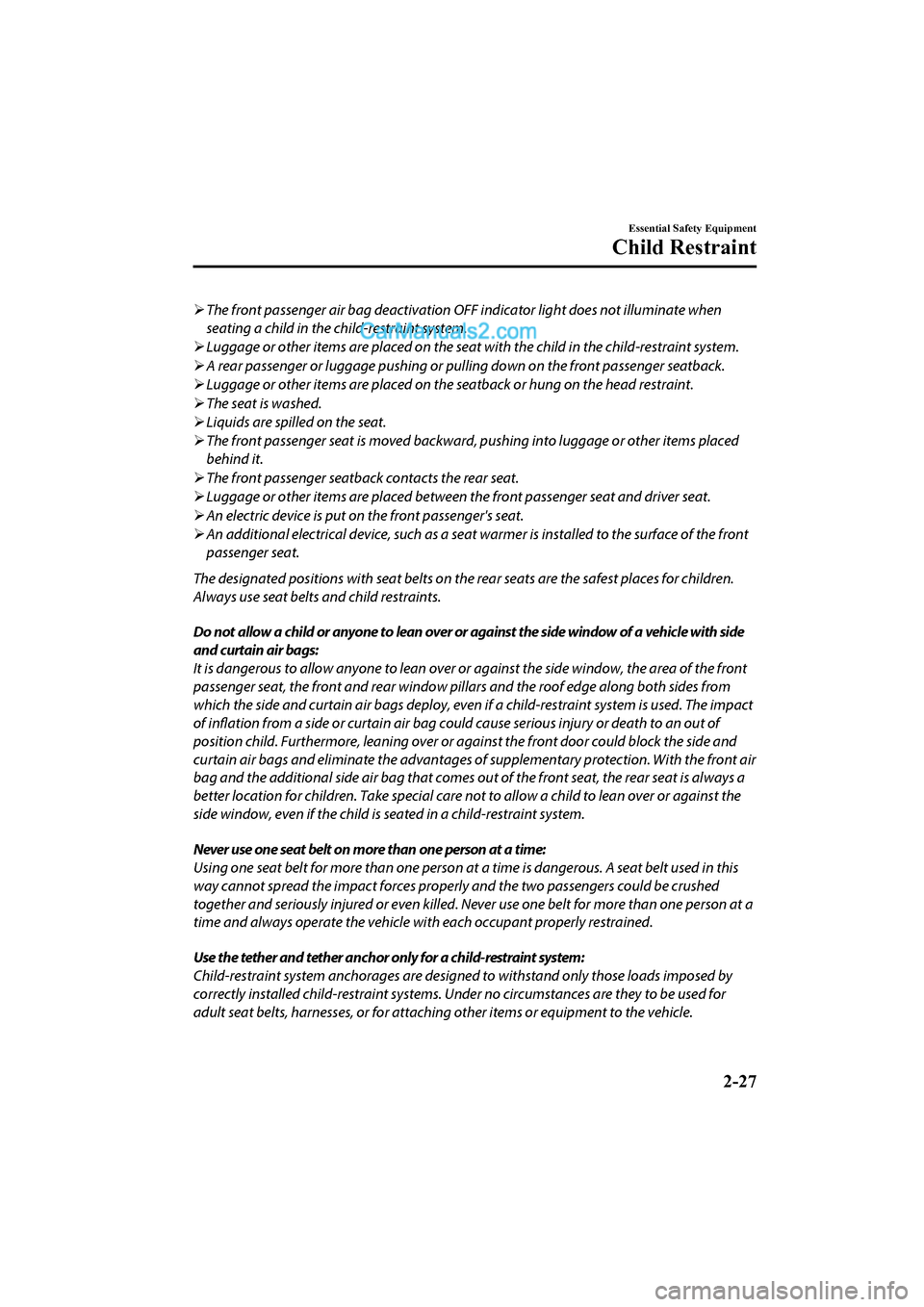
The front passenger air bag deactivation OFF indicator light does not illuminate when
seating a child in the child-restraint system.
Luggage or other items are placed on the seat with the child in the child-restraint system.
A rear passenger or luggage pushing or pulling down on the front passenger seatback.
Luggage or other items are placed on the seatback or hung on the head restraint.
The seat is washed.
Liquids are spilled on the seat.
The front passenger seat is moved backward, pushing into luggage or other items placed
behind it.
The front passenger seatback contacts the rear seat.
Luggage or other items are placed between the front passenger seat and driver seat.
An electric device is put on the front passenger's seat.
An additional electrical device, such as a seat warmer is installed to the surface of the front
passenger seat.
The designated positions with seat belts on the rear seats are the safest places for children.
Always use seat belts and child restraints.
Do not allow a child or anyone to lean over or against the side window of a vehicle with side
and curtain air bags:
It is dangerous to allow anyone to lean over or against the side window, the area of the front
passenger seat, the front and rear window pillar s and the roof edge along both sides from
which the side and curtain air bags deploy, even if a child-restraint system is used. The impact
of inflation from a side or curtain air bag could cause serious injury or death to an out of
position child. Furthermore, le aning over or against the front door could block the side and
curtain air bags and eliminate th e advantages of supplementary protection. With the front air
bag and the additional side air bag that comes out of the front seat, the rear seat is always a
better location for children. Take special care not to allow a child to lean over or against the
side window, even if the child is seated in a child-restraint system.
Never use one seat belt on more than one person at a time:
Using one seat belt for more than one person at a time is dangerous. A seat belt used in this
way cannot spread the impact forces properly and the two passengers could be crushed
together and seriously injured or even killed. Ne ver use one belt for more than one person at a
time and always operate the vehicle wi th each occupant properly restrained.
Use the tether and tether anchor only for a child-restraint system:
Child-restraint system anchorages are design ed to withstand only those loads imposed by
correctly installed child-restraint systems. Und er no circumstances are they to be used for
adult seat belts, harnesses, or for attach ing other items or equipment to the vehicle.
Essential Safety Equipment
Child Restraint
2-27
2017-6-7 7:51:19 Form No. CX-5 8FY4-EE-17E+L_Edition2
Page 53 of 772
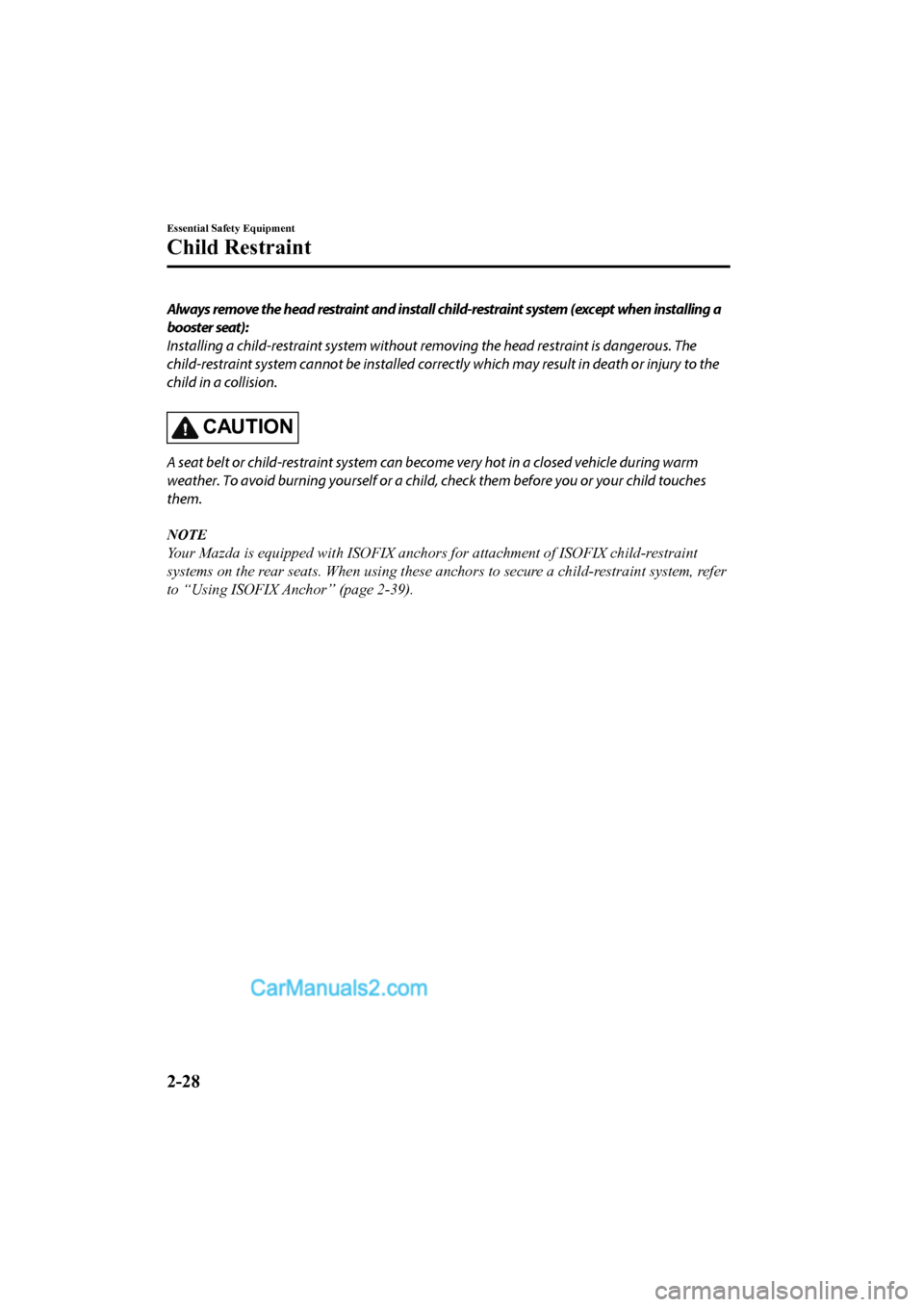
Always remove the head restraint and install child-restraint system (except when installing a
booster seat):
Installing a child-restraint system without removing the head restraint is dangerous. The
child-restraint system cannot be installed correctly which may result in death or injury to the
child in a collision.
CAUTION
A seat belt or child-restraint system can become very hot in a closed vehicle during warm
weather. To avoid burning yourself or a child, check them before you or your child touches
them.
NOTE
Your Mazda is equipped with ISOFIX anchors for attachment of ISOFIX child-restraint
systems on the rear seats. When using these anchors to secure a child-restraint system, refer
to “Using ISOFIX Anchor” (page 2-39).
Essential Safety Equipment
Child Restraint
2-28
2017-6-7 7:51:19 Form No. CX-5 8FY4-EE-17E+L_Edition2
Page 54 of 772
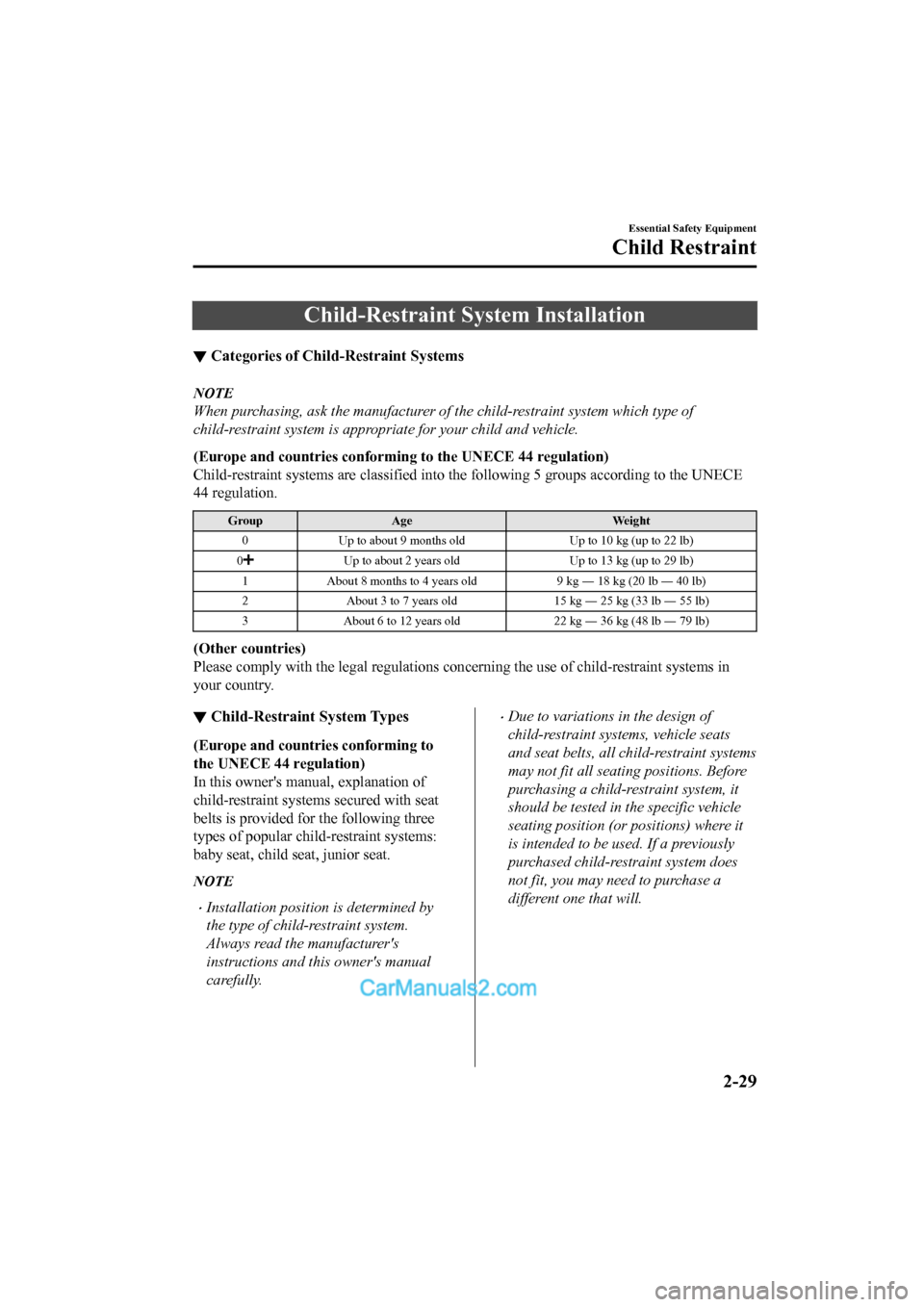
Child-Restraint System Installation
▼Categories of Child-Restraint Systems
NOTE
When purchasing, ask the manufacturer of the child-restraint system which type of
child-restraint system is appropriate for your child and vehicle.
(Europe and countries conformin
g to the UNECE 44 regulation)
Child-restraint systems are clas sified into the following 5 groups according to the UNECE
44 regulation.
Group Age Weight
0 Up to about 9 months old Up to 10 kg (up to 22 lb)
0
Up to about 2 years old Up to 13 kg (up to 29 lb)
1 About 8 months to 4 years old 9 kg ― 18 kg (20 lb ― 40 lb)
2 About 3 to 7 years old 15 kg ― 25 kg (33 lb ― 55 lb)
3 About 6 to 12 years old 22 kg ― 36 kg (48 lb ― 79 lb)
(Other countries)
Please comply with the legal regulations concerning the use of child-restraint systems in
your country.
▼ Child-Restraint System Types
(Europe and countries conforming to
the UNECE 44 regulation)
In this owner's manual, explanation of
child-restraint syste
ms secured with seat
belts is provided for the following three
types of popular child-restraint systems:
baby seat, child seat, junior seat.
NOTE
•Installation position is determined by
the type of child-restraint system.
Always read the manufacturer's
instructions and this owner's manual
carefully.
•Due to variations in the design of
child-restraint systems, vehicle seats
and seat belts, all child-restraint systems
may not fit all seating positions. Before
purchasing a child-restraint system, it
should be tested in the specific vehicle
seating position (or positions) where it
is intended to be used. If a previously
purchased child-restraint system does
not fit, you may need to purchase a
different one that will.
Essential Safety Equipment
Child Restraint
2-29
2017-6-7 7:51:19 Form No. CX-5 8FY4-EE-17E+L_Edition2
Page 55 of 772
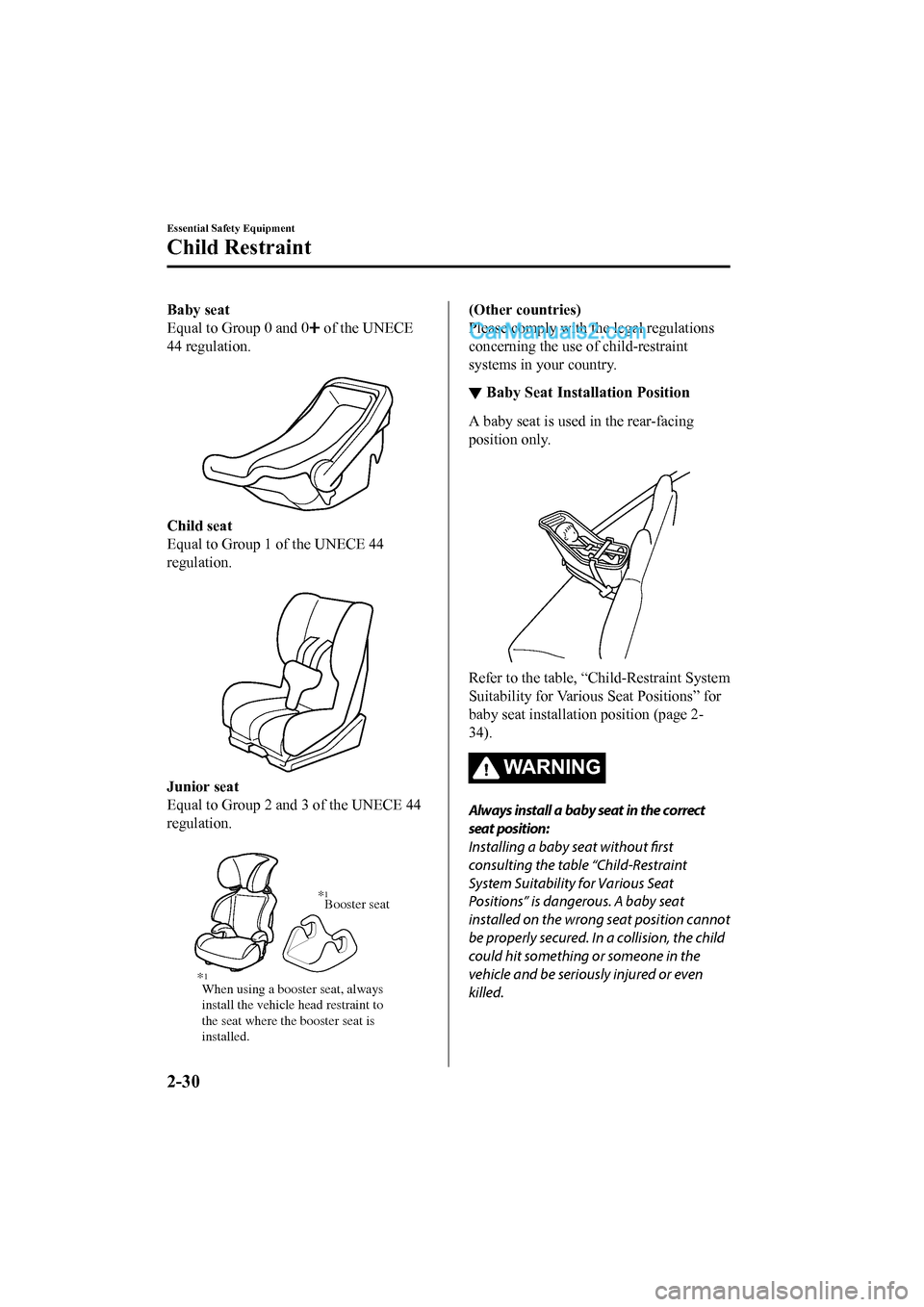
Baby seat
Equal to Group 0 and 0
of the UNECE
44 regulation.
Child seat
Equal to Group 1 of the UNECE 44
regulation.
Junior seat
Equal to Group 2 and 3 of the UNECE 44
regulation.
When using a booster seat, always
install the vehicle head restraint to
the seat where the booster seat is
installed. Booster seat
*
1
*1
(Other countries)
Please comply with th
e legal regulations
concerning the use o f child-restraint
systems in your country.
▼ Baby Seat Installation Position
A baby seat is used in the rear-facing
position only.
Refer to the table, “C
hild-Restraint System
Suitability for Various Seat Positions” for
baby seat installation position (page 2-
34).
WA R N I N G
Always install a baby seat in the correct
seat position:
Installing a baby seat without first
consulting the table “Child-Restraint
System Suitability for Various Seat
Positions” is dangerous. A baby seat
installed on the wrong seat position cannot
be properly secured. In a collision, the child
could hit something or someone in the
vehicle and be seriously injured or even
killed.
Essential Safety Equipment
Child Restraint
2-30
2017-6-7 7:51:19 Form No. CX-5 8FY4-EE-17E+L_Edition2
Page 56 of 772
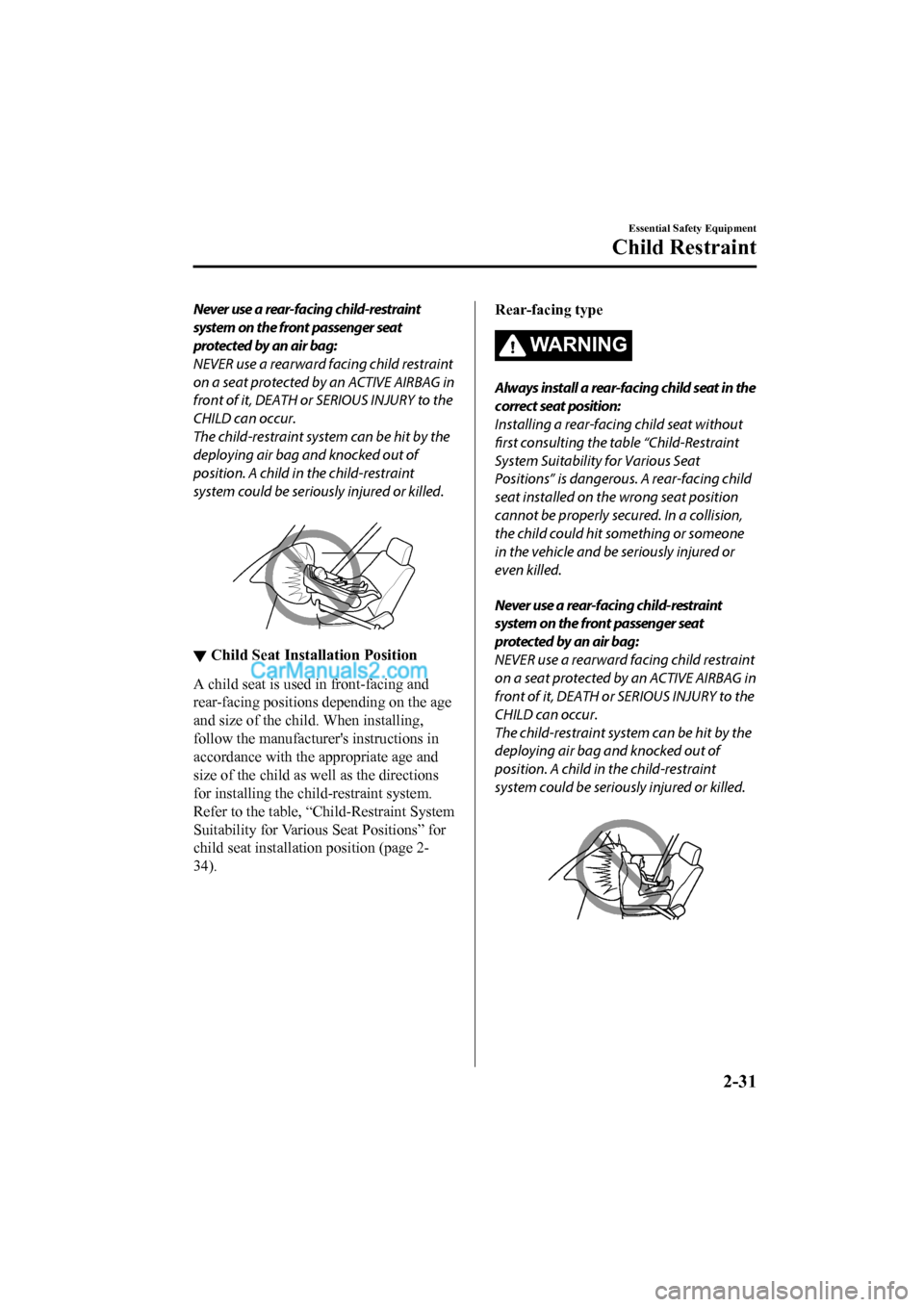
Never use a rear-facing child-restraint
system on the front passenger seat
protected by an air bag:
NEVER use a rearward facing child restraint
on a seat protected by an ACTIVE AIRBAG in
front of it, DEATH or SERIOUS INJURY to the
CHILD can occur.
The child-restraint system can be hit by the
deploying air bag and knocked out of
position. A child in the child-restraint
system could be seriously injured or killed.
▼Child Seat Installation Position
A child seat is used in front-facing and
rear-facing positions depending on the age
and size of the child. When installing,
follow the manufacturer's instructions in
accordance with the appropriate age and
size of the child as well as the directions
for installing the child-restraint system.
Refer to the table, “Child-Restraint System
Suitability for Various
Seat Positions” for
child seat installation position (page 2-
34).
Rear-facing type
WA R N I N G
Always install a rear-facing child seat in the
correct seat position:
Installing a rear-facing child seat without
first consulting the table “Child-Restraint
System Suitability for Various Seat
Positions” is dangerous. A rear-facing child
seat installed on the wrong seat position
cannot be properly secured. In a collision,
the child could hit something or someone
in the vehicle and be seriously injured or
even killed.
Never use a rear-facing child-restraint
system on the front passenger seat
protected by an air bag:
NEVER use a rearward facing child restraint
on a seat protected by an ACTIVE AIRBAG in
front of it, DEATH or SERIOUS INJURY to the
CHILD can occur.
The child-restraint system can be hit by the
deploying air bag and knocked out of
position. A child in the child-restraint
system could be seriously injured or killed.
Essential Safety Equipment
Child Restraint
2-31
2017-6-7 7:51:19 Form No. CX-5 8FY4-EE-17E+L_Edition2
Page 57 of 772
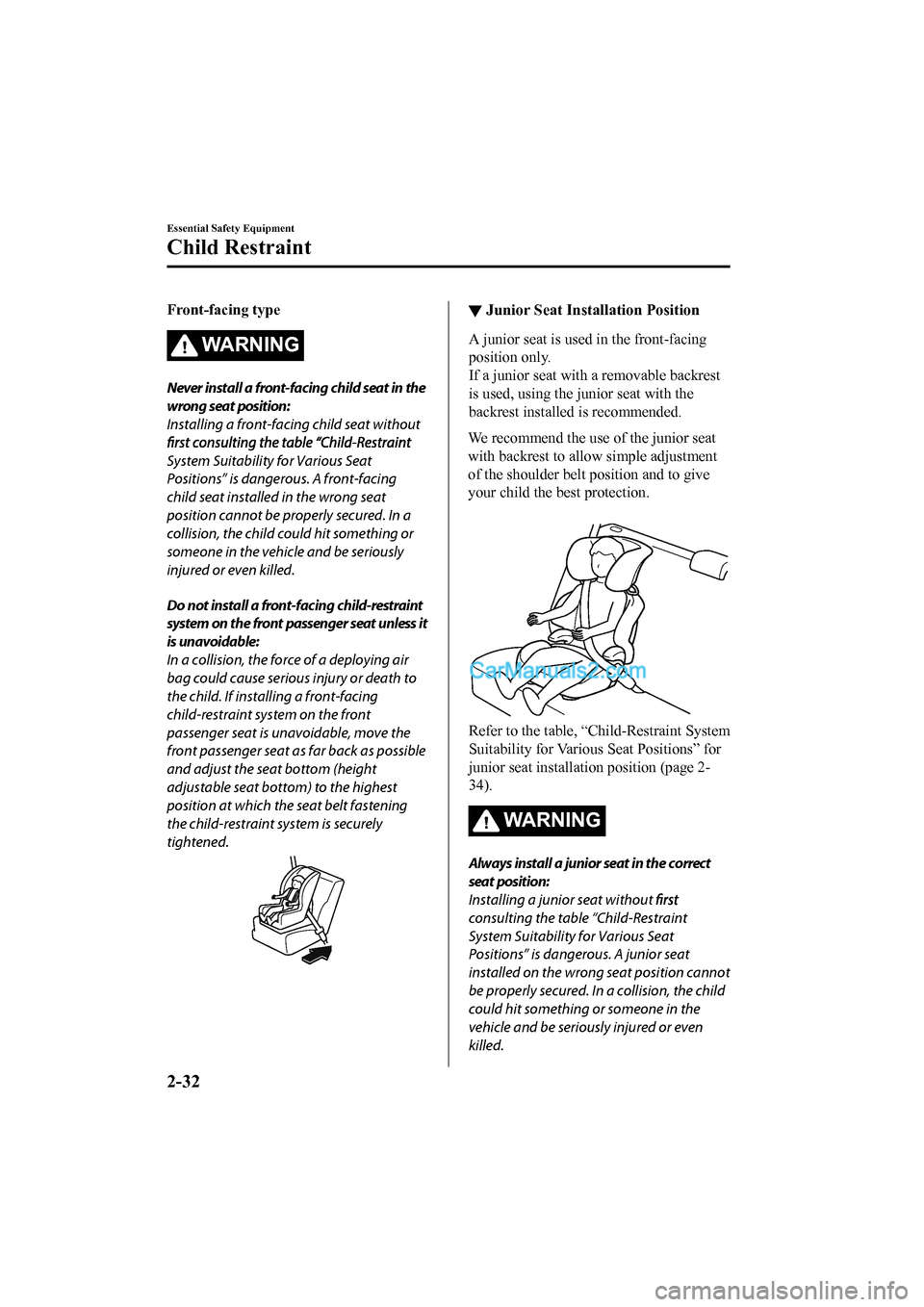
Front-facing type
WARNING
Never install a front-facing child seat in the
wrong seat position:
Installing a front-facing child seat without
System Suitability for Various Seat
Positions” is dangerous. A front-facing
child seat installed in the wrong seat
position cannot be properly secured. In a
coll ision, the child could hit something or
someone in the vehicle and be seriously
injured or even killed.
Do n ot install a front-facing child-re straint
system on the front pa ssenger seat unless it
is unavoid able:
In a collision, the force of a deploying air
bag could cause serious injury or death to
the child. If installing a front-facing
child-restraint system on the front
passenger seat is unavoidable, move the
front passenger seat as far back as possible
and adjust the seat bottom (height
adjustable seat bottom) to the highest
position at which the seat belt fastening
the child-restraint system is securely
tightened.
Junior Seat Installation Position
A junior sea t is used in the front-facing
pos ition only.
If a junior seat with a removable backr est
is used, usin g the j unior s eat with the
b ack rest ins talled is recommended.
Refer to the table, “Child-Restraint System
Suitabil ity for Various S eat Positions” for
junior seat inst allation pos ition (page 2-
34).
WARNING
Always inst all a junior se at in the co rrect
seat position:
Installing a junior seat without
consulting the table “Child-Restraint
System Suitability for Various Seat
Positions” is dangerous. A junior seat
installed on the wrong seat position cannot
be properly secured. In a collision, the child
could hit something or someone in the
vehicle and be seriously injured or even
killed.
Essential Safety Equipment
Child Restraint
2-32
2017-6-7 7:51:19Form No. CX-5 8FY4-EE-17E+L_Edition2
We recommend the use of the junior seat
with backrest to allow simple adjustment
of the shoulder belt position and to give
your child the best protection.
Page 58 of 772
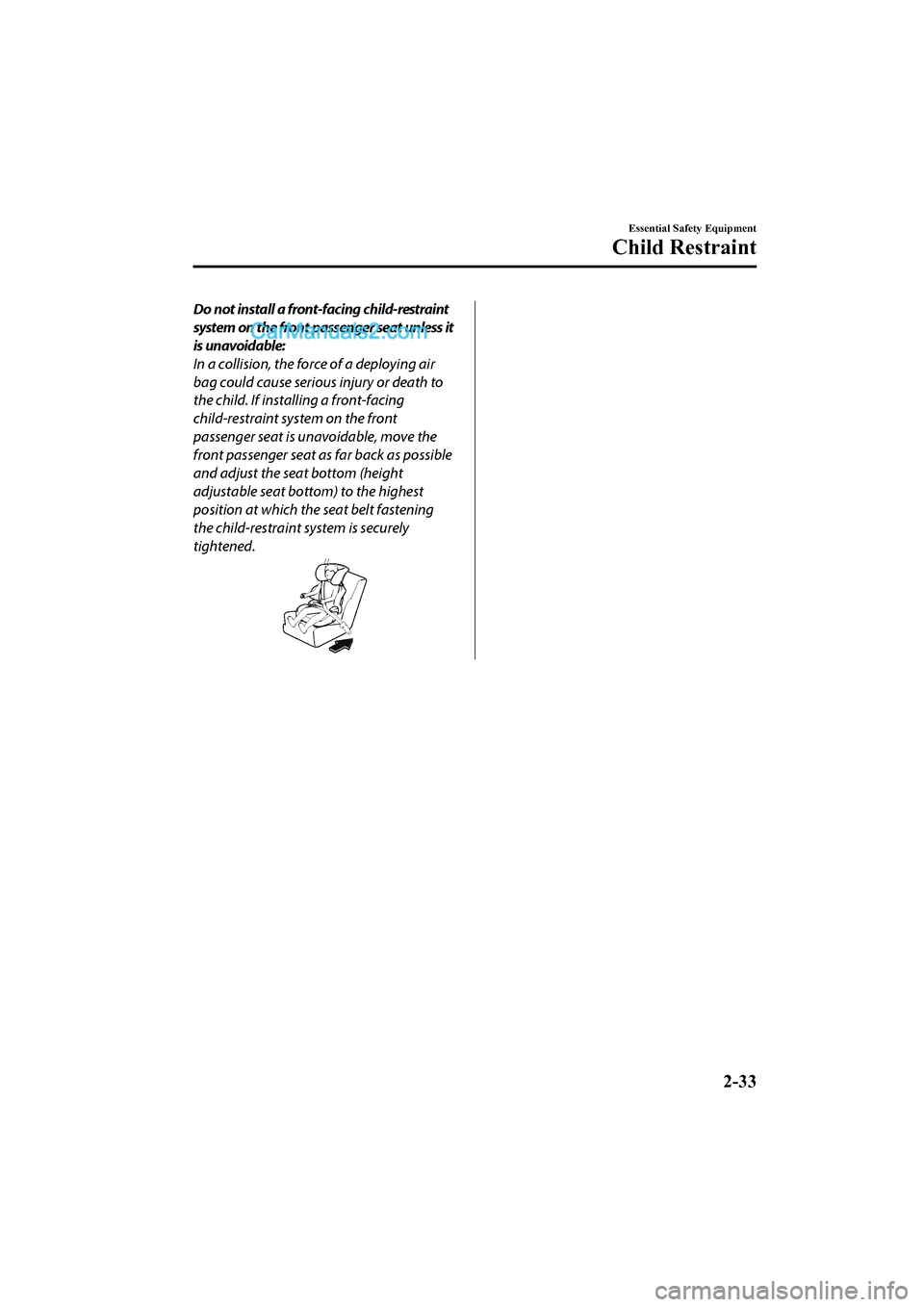
Do not install a front-facing child-restraint
system on the front passenger seat unless it
is unavoidable:
In a collision, the force of a deploying air
bag could cause serious injury or death to
the child. If installing a front-facing
child-restraint system on the front
passenger seat is unavoidable, move the
front passenger seat as far back as possible
and adjust the seat bottom (height
adjustable seat bottom) to the highest
position at which the seat belt fastening
the child-restraint system is securely
tightened.
Essential Safety Equipment
Child Restraint
2-33
2017-6-7 7:51:19Form No. CX-5 8FY4-EE-17E+L_Edition2
Page 59 of 772
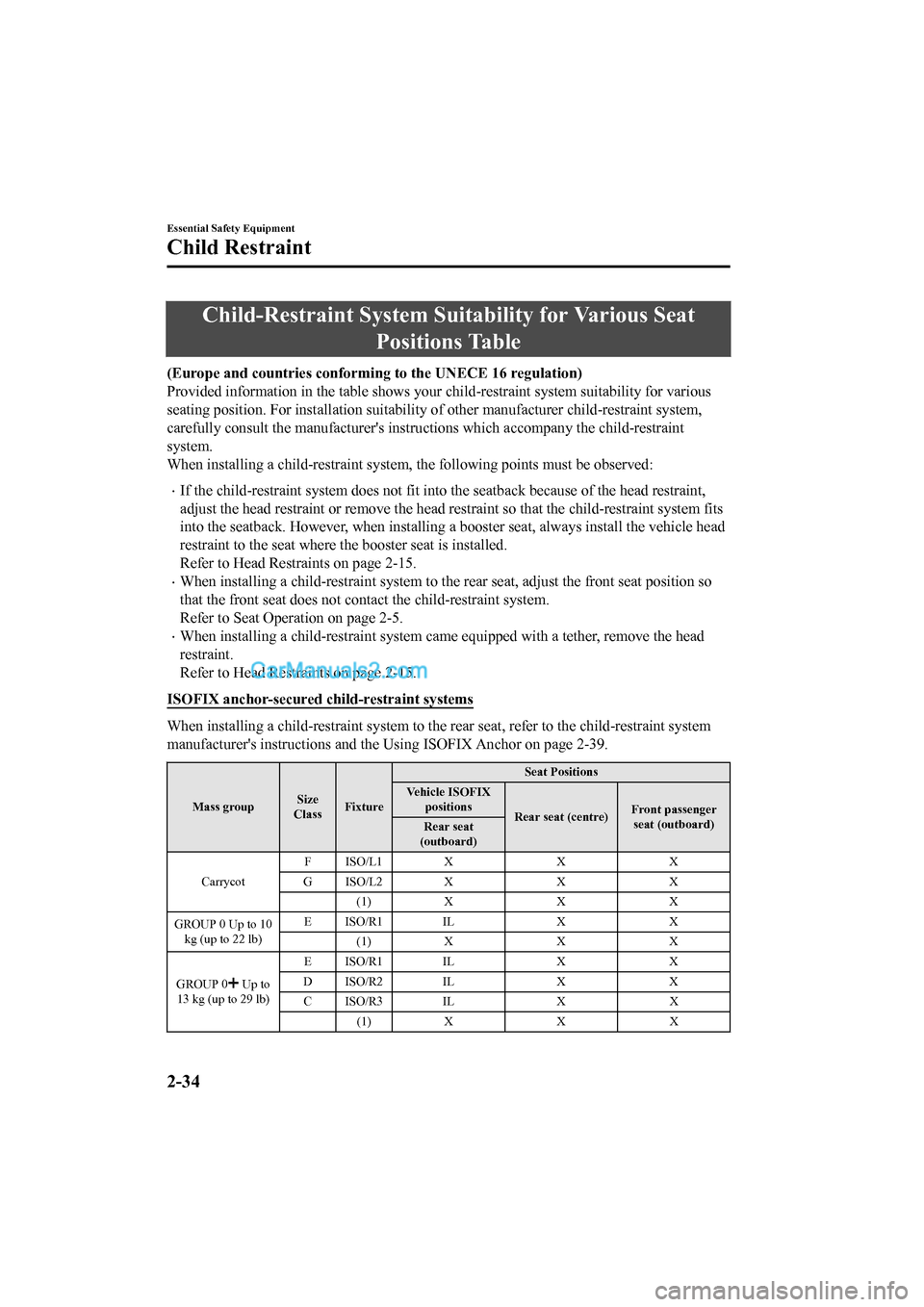
Child-Restraint System Suitability for Various SeatPositions Table
(Europe and countries conformi ng to the UNECE 16 regulation)
Provided information in the table shows your child-restraint sy stem suitability for various
seating position. For installati on suitability of other manufacturer child-restraint system,
carefully consult the manufacturer's instructions which accompa ny the child-restraint
system.
When installing a child-restrain t system, the following points must be observed:
•If the child-restraint system doe s not fit into the seatback be cause of the head restraint,
adjust the head restraint or remove the head restraint so that the child-restraint system fits
into the seatback. Howe ver, when installing a booster seat, alw ays install the vehicle head
restraint to the seat where the booster seat is installed.
Refer to Head Restraints on page 2-15.
•When installing a child-restrain t system to the rear seat, adjust the front seat position so
that the front seat does not cont act the child-restraint system.
Refer to Seat Operation on page 2-5.
•When installing a child-restrain t system came equipped with a t ether, remove the head
restraint.
Refer to Head Restraints on page 2-15.
ISOFIX anchor-secured child-restraint systems
When installing a child-restraint system to the rear seat, refe r to the child-restraint system
manufacturer's instructions and the Using ISOFIX Anchor on page 2-39.
Mass groupSize
Class Fixture Seat Positions
Vehicle ISOFIX positions Rear seat (centre) Front passenger
seat (outboard)
Rear seat
(outboard)
Carrycot FISO/L1 X
XX
GISO/L2 X XX
(1) X XX
GROUP 0 Up to 10 kg (up to 22 lb) EISO/R1 IL
XX
(1) X XX
GROUP 0
Up to
13 kg (up to 29 lb) EISO/R1 IL
XX
DISO/R2 IL XX
CISO/R3 IL XX
(1) X XX
Essential Safety Equipment
Child Restraint
2-34
2017-6-7 7:51:19 Form No. CX-5 8FY4-EE-17E+L_Edition2
Page 60 of 772

Mass groupSize
Class Fixture Seat Positions
Vehicle ISOFIX positions Rear seat (centre) Front passenger
seat (outboard)
Rear seat
(outboard)
GROUP 1 9 kg ― 18 kg (20 lb ― 40 lb) DISO/R2 IL
XX
CISO/R3 IL XX
BISO/F2 IUF XX
B1 ISO/F2X IUF XX
AISO/F3 IUF XX
(1) X X X
GROUP 2 15 kg ― 25 kg (33 lb ― 55 lb) (1)
IL XX
GROUP 3 22 kg ― 36 kg (48 lb ― 79 lb) (1)
IL XX
(1) For the CRS which do not carry the ISO/XX size class identi fication (A to G), for the applicable mass group, the
car manufacturer shall indicate t he vehicle specific ISOFIX child-restraint system(s) recommended for each
position.
Key of letters to be inserted in the above table:
IUF = suitable for ISOFIX forward child-restraints systems of u niversal category approved for use in this mass
group.
IL = suitable for particular ISO FIX child-restraint systems (CR S).
These ISOFIX CRS are those of the “specific vehicle”, “restricted” or “semi-universal” categories.
A Mazda genuine child-restraint system can be installed. Regard ing child-restraint systems which can be installed,
refer to the accessories catalog.
(Except Europe)
Regarding child-restraint systems which can be installed to you r Mazda, consult an expert repairer, we recommend
an Authorised Mazda Repairer.
X = ISOFIX position not suitable for ISOFIX child-restraint systems in this mass group and/or this size class.
i-Size child-restraint systems
Vehicles with the mark indicated on the front surface of a rear seatback are i-S ize
child-restraint certified.
When installing a child-restraint system to the rear seat, refer to the child-restraint system
manufacturer's instructions and the Using ISOFIX Anchor on page 2-39.
Essential Safety Equipment
Child Restraint
2-35
2017-6-7 7:51:19 Form No. CX-5 8FY4-EE-17E+L_Edition2